Spine
Spine Anatomy
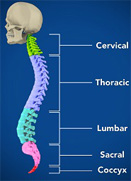
The spine, also called the back bone, plays a vital role in stability, smooth movement and protection of the delicate spinal cord. It is made up of bony segments called vertebrae with fibrous tissue called intervertebral discs between them. The vertebrae and discs form the spinal column from the head to the pelvis, giving symmetry and support to the body.
A single vertebra is made up of two parts, the front portion is called the body and the back portion is referred to as the vertebral or neural arch. The body is cylindrical in shape, strong and stable. Two strong pedicle bones join the vertebral arch to the body of the vertebrae.
Spine Conditions
Cervical Disc Herniation
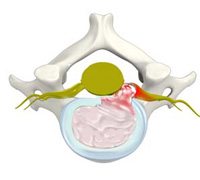
Herniation of a disc is an anomalous spine condition characterized by leakage of the inner contents of the intervertebral disc, due to cracks in its outer wall. Herniated disc is commonly seen in the cervical or neck region, a condition called cervical herniated disc (CHD). CHD is followed by arm or neck pain that may arise due to compression of the spinal nerves by the protruding disc material.
Scoliosis
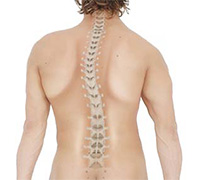
Scoliosis is a condition where the spine or back bone is curved sideways instead of appearing in a straight line. It can occur in all ages, but commonly occurs in children before puberty, during their growth spurt.
Cervical Myelopathy
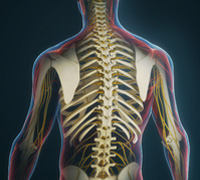
Disc protrusions in the cervical or neck area place pressure on nerve roots (nerve root compression) or the spinal cord causing radiculopathy. Radiculopathy is a medical term used to describe the neurological deficits that can occur from pressure on the nerves and spinal cord, such as arm or finger weakness, numbness or pain. Cervical radiculopathy refers to a dysfunction of a nerve root caused by injury or compression of a spinal nerve root in the neck. On the other hand, cervical myelopathy refers to compression of the spinal cord within the neck.
Cervical Stenosis

Cervical stenosis refers to narrowing of the spinal canal that protects the spinal cord and its branching nerves. The condition causes neck pain radiating to arms and hands, numbness or weakness in the legs. This condition causes cervical myelopathy and cervical radiculopathy. The abnormal pressure placed on the spinal cord causes damage and results in spinal cord dysfunction. This condition is known as myelopathy. Cervical radiculopathy occurs when the nerve roots connecting the spinal cord are injured or pinched as they exit the spinal canal. Myeloradiculopathy occurs when there is damage to the spinal cord and nerve roots.
Chronic Neck Pain

Common neck pain may occur from muscle strain or tension in everyday activities including poor posture, prolonged use of a computer and sleeping in an uncomfortable position.
The most common cause of neck pain is injury to the soft tissues (muscles, ligaments or nerves) or prolonged wear and tear. Traumatic accidents or falls and contact sports can cause severe neck injuries causing pain in the neck. Neck pain can also come from infections, tumors or congenital abnormalities of the vertebrae.
Degenerative Disc Disease
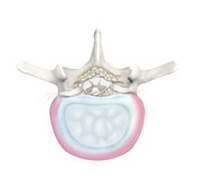
Degenerative disc disease (DDD) refers to gradual deterioration of the intervertebral discs between the vertebrae. DDD is a misnomer as it is not actually a disease but a condition that affects the strength, resiliency and structural integrity of the intervertebral discs due to advancing age, trauma, injury, repetitive movement, improper posture, or poor body mechanics. DDD is commonly seen in individuals over 50 years of age. Most of them are usually not aware about their condition until they are examined for some other related health condition.
Degenerative Scoliosis

Scoliosis is a condition characterized by abnormal curvature of the spine causing a deviation to one side. It causes a physical deformity making the spine look like the letter "C" or "S" instead of the letter "I". Scoliosis can affect either the mid or the lower back, but the scoliosis of the mid back is more common. Scoliosis can occur at any age.
Herniated Disc

Disc herniation is the most common cause of back pain. The intervertebral discs are flat and round, present between vertebrae and act as shock absorbers when you walk or run. There is a soft, gelatinous material in the center (nucleus pulposus) which is encased in strong elastic tissue forming a ring around it called annulus fibrosus.
Disc herniation is a condition where the central nucleus pushes through the outer edge of the disk, causing a bulge that compresses the spinal nerves.
Kyphosis

Kyphosis is a condition of abnormal curvature of the spine that causes rounding of the upper back or a hunchback. The thoracic portion of the spine normally has a C-shaped curve, but excessive forward curve in the spine leads to kyphosis. In adults, kyphosis may develop because of degenerative diseases such as arthritis, disc degeneration, osteoporotic fractures, traumatic injuries and slippage of vertebral disc. Kyphosis most commonly affects the thoracic spine, but can involve the cervical and lumbar portions too.
Lumbar Disc Herniation
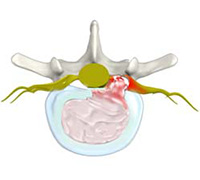
Lumbar disc herniation is the most common cause of low back pain and leg pain (sciatica). The lumbar intervertebral discs are flat and round, present between the lumbar vertebrae and act as shock absorbers when you walk or run. There is a soft, gelatinous material in the center (nucleus pulposus) which is encased in strong elastic tissue forming a ring around it called annulus fibrosus.
Lumbar Radiculopathy
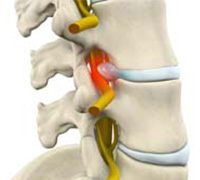
Back pain is a common condition affecting approximately 80% of the population at some point in their lives. The area usually affected is the lower back (lumbar region) as it bears most of the upper body's weight. Pain in the lower back may sometimes radiate to the legs. This is referred to as lumbar radiculopathy or sciatica. Lumbar radiculopathy can be extremely debilitating and interferes with your daily activities.
Lumbar Stenosis

Lumbar stenosis is the compression of spinal nerves caused by narrowing of the spinal canal and it is one of the common causes of low back pain. Spinal stenosis can also affect the spine in the neck region. The symptoms include back pain, burning or aching type of pain in the buttocks that radiates to the legs (sciatica), weakness in the legs or "foot drop". One of the causes for spinal stenosis is ageing and other causes include Paget's disease, achondroplasia, spinal tumors and spinal injuries. As age advances the chances of developing osteoarthritis, disc degeneration and thickening of ligaments may increase and these conditions cause spinal stenosis.
Neck Fracture

The neck is made up of seven tiny bones called cervical vertebrae (C1-C7). These are protected by spongy vertebral discs present between them and supported by ligaments that hold them together and surround the underlying spinal cord. Cervical fractures are common in motor vehicle accidents, sports activities and falls. The second, sixth and seventh cervical vertebrae are frequently involved in fractures, and may also injure the spinal cord.
Sciatica

Sciatica is a painful condition caused by the irritation of the sciatic nerve. The sciatic nerve is the longest nerve in our bodies. It begins in the lower back and extends through the buttocks down the back of each leg to the thighs and feet.
Sciatica can be acute (short term) lasting a few weeks or chronic (long term) persisting for more than 3 months. It is important to understand that in most cases sciatica will resolve itself within a few weeks or months and rarely causes permanent nerve damage.
Spina Bifida

Coming soon
Spinal Deformity
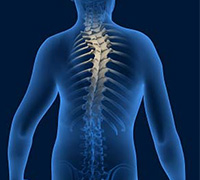
The Spine or backbone provides stability to the upper part of our body. It helps to hold the body upright. It consists of a series of irregularly shaped bones appearing in a straight line. The spine has two gentle curves, when looked from the side and appears to be straight when viewed from the front. When these curves are exaggerated, pronounced problems can occur such as back pain, breathing difficulties and fatigue.
Spinal Stenosis

Spinal stenosis is a condition caused from the vertebral column constricting and exerting pressure on the spinal cord or neural foramen (a bony tunnel through which a nerve exits the spinal cord).
Spinal Stenosis usually affects the cervical and lumbar spine. If the spinal canal is narrowed, the disorder is called cervical/lumbar central stenosis. If the foramen is narrowed, it is referred to as cervical/lumbar foraminal stenosis.
Spinal Tumors
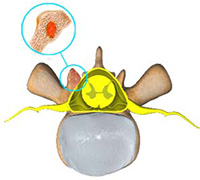
Spine tumor is the abnormal growths of uncontrolled tissues or cells in and around the spinal cord. Tumors can either be cancerous (malignant) or non-cancerous (benign). Some of the commonly occurring benign spinal tumors are osteoma, osteoblastoma, hemangioma, and osteochondroma. Most commonly occurring malignant spinal tumors are chondrosarcoma, Ewing's sarcoma, lymphoma, osteosarcoma, and multiple myeloma. Tumors that begin in the spine are called as primary spinal tumors. Tumors that spread to the spine from other parts such as the breast, prostate, lung, and other areas are called secondary spinal tumors.
Spondylolisthesis

Spondylolisthesis is the displacement of vertebral disc from the spinal column. Outward (forward) displacement is termed as anterolisthesis and inward (backward) displacement is termed as retrolisthesis. This condition is often preceded by spondylolysis, a degenerative condition of the vertebra.
Spondylolysis
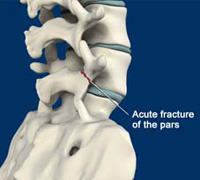
Spondylolysis is a stress fracture of vertebra that may progress into spondylolisthesis, a condition of displacement of vertebrae from the spinal column. Spondylolysis is the cause for frequent low back pain in children. It is more common among children and teenagers who participate actively in sports such as football, weightlifting and gymnastics.
Spondylolysis occurs because of a defect or stress fracture in the pars interarticularis, the part of the lumbar spine joining the upper and lower joints. Genetic factors may have a role. Children born with thin vertebra are prone to vertebral stress fractures. Also, repetitive trauma to the lower back area that occurs during sports and other activities can cause weakness of the pars interarticularis, resulting in spondylolysis.
Spine Treatments
Spinal Fusion
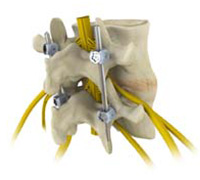
Spinal fusion is the surgical technique of combining two or more vertebrae. Fusion of the vertebrae involves insertion of secondary bone tissue obtained either through auto graft (tissues from the same patient) or allograft (tissues from another person) to augment the bone healing process.
Lumbar (lower back) region of the spine is more prone to spine fusion when compared to the other regions such as cervical (neck) and thoracic (mid back) parts of the spine. Usually spinal fusion is recommended in patients with neurological problems or severe pain that have not responded to conservative treatment.
Cervical Artificial Discs

Coming Soon
Laminectomy

Laminectomy refers to removal or cutting of the lamina (roof) of the vertebral bones to provide space for the nerves to exit from the spine. It can also be performed to relieve the symptoms of narrowed spinal canal known as spinal stenosis.
Computer Enhanced Navigation: Image Guided Spine Surgery

Imaging techniques such as computed tomography and fluoroscopy may be integrated into the system to facilitate pre-operative planning of the surgery, where a series of images taken before the surgery are displayed on a screen, with which your surgeon matches his/her moves intraoperatively. They can also serve as real-time guidance, where your surgeon can view, and navigate instruments and implants as they are placed during the surgery.
Minimally Invasive Spine Surgery
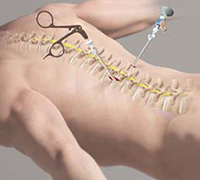
MISS is the latest advanced technology available to perform spinal surgeries through small, less than one inch long, incisions. It involves the use of special surgical instruments, devices and advanced imaging techniques to visualize and perform the surgery through such small incisions. MISS is aimed at minimizing damage to the muscles and surrounding structures.
Spinal Implants

Coming soon
ALIF: Anterior Lumbar Interbody Fusion
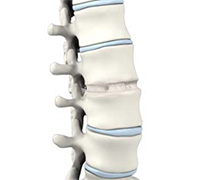
Anterior lumbar interbody fusion (ALIF) is a surgery performed to correct the spinal problems in the lower back. The surgery can be implemented either as an open surgery or minimally invasive technique.
DLIF: Direct Lateral Interbody Fusion

Direct lateral interbody fusion (DLIF) is a type of lumbar interbody fusion (LIF) surgery. In DLIF surgery, the spine is also approached from the side. Using minimally invasive technique, the underlying soft tissues and the psoas muscle are gently separated to reach the intervertebral disc. As the spine is approached through the psoas muscle, DLIF is also known as trans-psoas approach.
PLIF: Posterior Lumbar Interbody Fusion
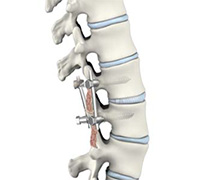
Spinal fusion is a surgical technique used to join two or more vertebrae in the spine and to minimize the pain caused by movement of these vertebrae. Fusion of vertebrae in the lumbar portion of the spine is called as lumbar fusion and the surgery can be done as an open or minimally invasive procedure.
Transforaminal Lumbar Interbody Fusion
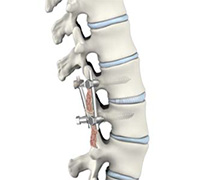
Transforaminal lumbar interbody fusion (TLIF) is a type of spinal fusion procedure in which bone graft is placed between the affected vertebrae in the lower back (lumbar) region through an incision on the patient's back.
Based on the spinal condition, age, activity levels, and the medical history of the patient, the surgeon may recommend TLIF as a treatment option.
Lateral Lumbar Interbody Fusion (XLIF)

Lateral lumbar interbody fusion also known as extreme lateral (XLIF) or direct lateral interbody fusion (DLIF) is a minimally invasive spinal procedure performed to treat back and leg pain caused by degenerative discs and other problems within the vertebral column.
Oblique Lumbar Interbody Fusion (OLIF)

Lumbar interbody fusion can be performed through different approaches. Oblique lumbar interbody fusion (OLIF) is a minimally invasive approach to LIF, where an incision is made on your side to avoid damaging important muscles and ligaments in your back.
Complex Spine and Corrective Surgery

Coming Soon
Anterior Cervical Discectomy and Fusion (ACDF)

Anterior cervical discectomy with fusion (ACDF) is a surgical procedure to treat a herniated disc in the cervical or neck region. The goals of surgery are to remove the damaged spinal disc or bony overgrowths causing nerve compressing and to fuse the adjacent vertebrae by placing bone graft in the space created. This procedure is performed by approaching the spine anteriorly or from the front of your neck.
Cervical Disc Arthroplasty

Cervical disc arthroplasty is performed to replace the joints in the neck region of the spine. The vertebral bones of the spine are separated by soft discs which can undergo injury or degeneration. Cervical disc arthroplasty involves replacing these discs with artificial prostheses and is also called cervical disc replacement surgery.
Spine Tumor

Spine tumor is the abnormal growths of uncontrolled tissues or cells in and around the spinal cord. Tumors can either be cancerous (malignant) or non-cancerous (benign). Some of the commonly occurring benign spinal tumors are osteoma, osteoblastoma, hemangioma, and osteochondroma. Most commonly occurring malignant spinal tumors are chondrosarcoma, Ewing’s sarcoma, lymphoma, osteosarcoma, and multiple myeloma. Tumors that begin in the spine are called as primary spinal tumors. Tumors that spread to the spine from other parts such as the breast, prostate, lung, and other areas are called secondary spinal tumors.
Revision Spine Surgery

Coming soon
Complex Spine Surgery

Complex spine surgery is a type of back surgery involving fusion of six or more vertebrae. The vertebrae are a series of small interlocking bones extending from the skull to the pelvis (hip) to form your spinal column or backbone. Spinal fusion helps in forming a solid bridge of bone that stabilizes your back. The surgery may involve the placement of screws and rods within the spine and may take six hours or longer to complete.
Bone Morphogenetic Protein (BMP)

Coming soon
